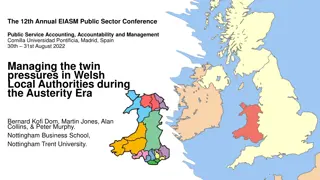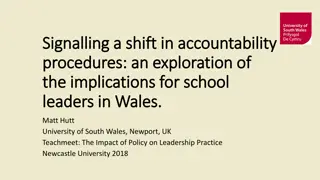Methods of Punishment in Welsh History: Impact and Reflection
Explore the historical developments in crime and punishment in Wales from the 1500s to the present day, focusing on methods of punishment and key figures such as John Howard, Dic Penderyn, Chartist leaders, and the Rebecca Riots. Delve into the impact of John Howard's campaign, the circumstances surrounding Dic Penderyn's execution, and the punishments endured by Chartist leaders, shedding light on the nature and methods of punishments in Wales throughout history.
Download Presentation

Please find below an Image/Link to download the presentation.
The content on the website is provided AS IS for your information and personal use only. It may not be sold, licensed, or shared on other websites without obtaining consent from the author.If you encounter any issues during the download, it is possible that the publisher has removed the file from their server.
You are allowed to download the files provided on this website for personal or commercial use, subject to the condition that they are used lawfully. All files are the property of their respective owners.
The content on the website is provided AS IS for your information and personal use only. It may not be sold, licensed, or shared on other websites without obtaining consent from the author.
E N D
Presentation Transcript
WJEC History GCSE 2017 Unit 3 Thematic studies from a broad historical perspective 3A: Changes in Crime and Punishment, c.1500 to the present day Methods of punishment
Background There is a choice of four thematic studies in Unit 3 Thematic studies from a broad historical perspective of the WJEC GCSE in history, from which centres must select one. These resources have been created to support teachers delivering 3A: Changes in Crime and Punishment, c.1500 to the present day , focusing on the impact of changes and developments in Wales. There are six PowerPoint resources relating to the first thematic study 3A: Changes in Crime and Punishment, c.1500 to the present day . This PowerPoint resource relates to the wider themes associated with Methods of punishment .
Content: Methods of punishment 1. What impact did John Howard s campaign have on the prison system in Wales? 2. Why was Dic Penderyn executed? 3. Chartist leaders 4. Rebecca Riots leaders 5. Stocks 6. Ruthin Gaol
1. What impact did John Howard s campaign have on the prison system in Wales? In his campaign to change conditions John Howard visited both Caernarfon and Swansea gaols alongside many other prisons in England, Ireland, Scotland and Europe. He described Caernarfon Gaol as having neither drainage or fresh water and the inmates housed in tiny windowless cells . As a direct result of Howard s criticisms, Thomas Penson built a new gaol in Caernarfon in 1784 and went on to improve the gaols in Wrexham and Flint. Further research: Was the solitary system meant for punishment or reform?
2. Why was Dic Penderyn executed? Does Dic Penderyn deserve a posthumous pardon? Use the information in the links to help you decide. Richard Lewis (Dic Penderyn) Biography by The National Library of Wales BBC News item on a posthumous pardon for Dic Penderyn A martyr for change: Wales first working class martyr from The Valleys Heroes website Use Welsh Newspapers Online to find out about other public executions in Wales Further thinking: What does this case reveal about the nature and methods of punishments in the 1830s?
3. Chartist leaders How were the Chartist leaders punished? What does their punishment reveal about the time? Find out by watching this BBC Bitesize clip and using the Chartist teaching materials on Hwb.
4. Rebecca Riots leaders Why were the leaders Dai r Cantwr and Shoni Sguborfawr transported?
Further resources on the Rebecca Riots leaders Dai r Cantwr Llanelli Community Heritage website history article on Dai r Cantwr Biography David Davies (Dai r Cantwr) by The National Library of Wales Shoni Sguborfawr Biography John Jones (Shoni Sguborfawr) by The National Library of Wales Further thinking: What does this case reveal about the nature and methods of punishments in the 1840s?
5. Stocks The last recorded use of stocks in Wales was in 1872 at Adpar, Newcastle Emlyn. Why were stocks a popular form of punishment for so long? Why did their usage end? Read a short article on Adpar s claim to fame here.
Further research on crimes, criminals and punishment in Wales The Crime and punishment database on the website of The National Library of Wales comprises data about crimes, criminals and punishments included in the gaol files of the Court of Great Sessions in Wales from 1730 until its abolition in 1830. (Note: Monmouthshire is not included.) Use the database to investigate crime and punishment in Wales. Devise a list of questions to help you interrogate the information. You could use the following questions as a starting point. What crimes were committed in your area? How many death sentences were given? How many were pilloried (stocks)? What were the age ranges?
6. Ruthin Gaol What can you learn from studying Ruthin Gaol as a historical site? For further information People s Collection Wales offers a range of sources.























